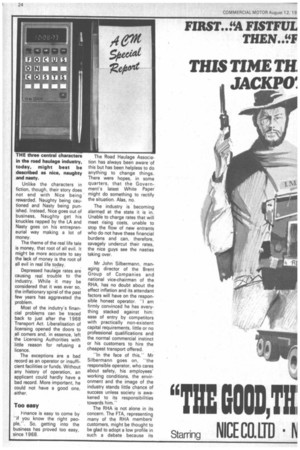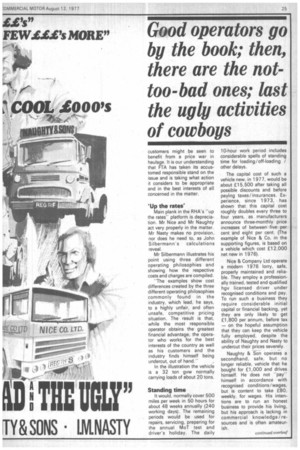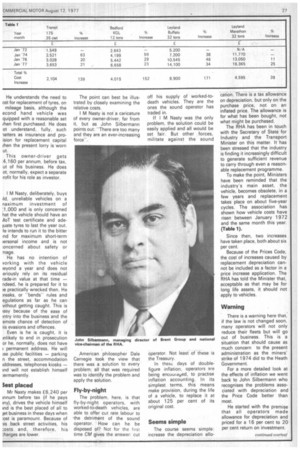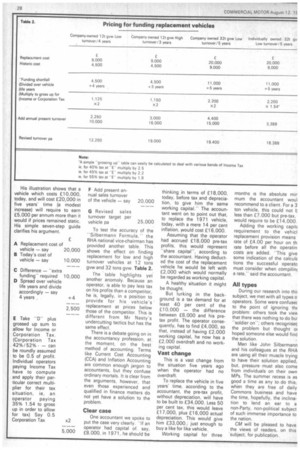THE three central characters in the road haulage industry, today, might best be described as nice, naughty and nasty.
Page 26

Page 27

Page 29

Page 30

If you've noticed an error in this article please click here to report it so we can fix it.
Unlike the characters in fiction, though, their story does not end with Nice being rewarded. Naughty being cautioned and Nasty being punished. Instead, Nice goes out of business, Naughty get his knuckles rapped by the LA and Nasty goes on his entrepreneurial way making a lot of money.
The theme of the real life tale is money, that root of all evil. It might be more accurate to say the lack of money is the root of all evil in real life today.
Depressed haulage rates are causing real trouble to the industry. While it may be considered that it was ever so, the inflationary spiral of the past few years has aggravated the problem.
Most of the indutry's financial problems can be traced back to just after the 1968 Transport Act. Liberalisation of licensing opened the doors to all corners and, in essence, left the Licensing Authorities with little reason for refusing a licence.
The exceptions are a bad record as an operator or insufficient facilities or funds. Without any history of operation, an applicant could hardly have a bad record. More important, he could not have a good one, either.
Too easy
Finance is easy to come by "if you know the right people,". So, getting into the business has proved too easy, since 1968. The Road Haulage Association has always been aware of this but has been helpless to do anything to change things. There were hopes, in some quarters, that the Government's latest White Paper might do something to rectify the situation. Alas, no.
The industry is becoming alarmed at the state it is in. Unable to charge rates that will meet rising costs, unable to stop the flow of new entrants who do not have these financial burdens and can, therefore, savagely undercut their rates, the nice guys see the nasties taking over.
Mr John Silbermann, managing director of the Brent Group of Companies and national vice-chairman of the RHA, has no doubt about the effect inflation and its attendant factors will have on the responsible honest operator. "I am firmly convinced he has everything stacked against him: ease of entry by competitors with practically non-existent capital requirements, little or no professional qualifications and the normal commercial instinct or his customers to hire the cheapest transport offered.
"In the face of this," Mr Silbermann goes on, "the responsible operator, who cares about safety, his employees' working conditions, the environment and the image of the industry stands little chance of success unless society is awakened to its responsibilities towards him."
The RHA is not alone in its concern. The FTA, representing many of the RHA members' customers, might be thought to be glad to adopt a low profile in such a debate because its customers might be seen to benefit from a price war in haulage. It is our understanding that FTA has taken its accustomed responsible stand on the issue and is taking what action it considers to be appropriate and in the best interests of all concerned in the matter.
'Up the rates'
Main plank in the RHA's
the ratesplatform is depreciation. Mr Nice and Mr Naughty act very properly in the matter. Mr Nasty makes no provision, nor does he need to, as John
Silbermann's calculations reveal.
Mr Silbermann illustrates his point using three different operating philosophies and showing how the respective costs and charges are compiled.
''The examples show cost differences created by the three different operating philosophies commonly found in the industry, which lead, he says, to a highly unfair, and often unsafe, competitive pricing situation. The result is that, while the most responsible operator obtains the greatest financial advantage, the operator who works for the best interests of the country as well as his customers and the industry finds himself being undercut, out of hand.
In the illustration the vehicle is a 32 ton gvw normally carrying loads of about 20 tons,
Standing time
It would, normally cover 500 miles per week in 50 hours for about 48 weeks annually (240 working days). The remaining periods would be used for repairs, servicing, preparing for the annual MoT test and driver's holiday. The daily 10-hour work period includes considerable spells of standing time for loading/off-loading / other delays.
The capital cost of such a vehicle new, in 1977, would be about £15,500 after taking all possible discounts and before paying taxes/insurances. Experience, since 1973, has shown that this capital cost roughly doubles every three to four years, as manufacturers announce three-monthly price increases of between five per cent and eight per cent. (The example of Nice & Co, in the supporting figures, is based on a vehicle which cost £12,000 net new in 1976).
Nice & Company Ltd operate a modern 1976 lorry, safe, properly maintained and reliable. They employ a professionally trained, tested and qualified hgv licensed driver under recognised conditions and pay. To run such a business they require considerable initial capital or financial backing, yet they are only likely to get £1,800 per annum, before tax — on the hopeful assumption that they can keep the vehicle fully employed, despite the ability of Naughty and Nasty to undercut their prices severely.
Naughty & Son operates a secondhand, safe, but no longer reliable, vehicle that he bought for £1,000 and drives himself. He does not "pay" himself in accordance with recognised conditions/wages, but is content to take £80, weekly, for wages. His intentions are to run an honest business to provide his living, but his approach is lacking in commercial knowledge/resources and is often amateurish. He understands the need to ost for replacement of tyres, on
mileage basis, although the econd hand vehicle was quipped with a reasonable set then first purchased. He does ot understand, fully, such -otters as insurance and proision for replacement capital then the present lorry is worn ut.
This owner-driver gets 4,160 per annum, before tax, ut of his business. He does ot, normally, expect a separate rofit for his role as investor.
I M Nasty, deliberately, buys Id, unreliable vehicles on a naximum investment of :1,000 and is only concerned hat the vehicle should have an AoT test certificate and adepate tyres to last the year out. le intends to run it to the bitter nd for maximum short-term iersonal income and is not :oncerned about safety or -nage.
He has no intention of vorking with the vehicle )eyond a year and does not :eriously rely on its residual rade-in value at that time — ndeed, he is prepared for it to )e practically wrecked then. He )reaks, or "bends" rules and egulations as far as he can vithout getting caught. This is asy because of the ease of !ntry into the business and the emote chance of detection of tis evasions and offences.
Even is he is caught, it is tnlikely to end in prosecution or he, normally, does not have permanent address. He will tse public facilities — parking n the street, accommodation iddresses, telephones kiosks — Ind will not establish himself )ermamently.
3est placed
Mr Nasty makes £6,240 per innum before tax (if he pays iny), drives the vehicle himself ind is the best placed of all to jet business in these days when :ost is paramount. Because of tis back street activities, his :osts and, therefore, his :Merges are lower. The point can best be illustrated by closely examining the relative costs.
I M Nasty is not a caricature of every owner-driver, far from it, but as John Silbermann points out: "There are too many and they are an ever-increasing force".
American philosopher Dale Carnegie took the view that there was a solution to every problem; all that was required was to identify the problem and apply the solution.
Fly-by-night The problem, here, is that fly-by-night operators, with worked-to-death vehicles, are able to offer cut rate labour to .the detriment of the sound operator. How can he be disposed of? Not for the fust time CM gives the answer. cut
off his supply of worked-todeath vehicles. They are the ones the sound operator has traded in.
If I M Nasty was the only problem, the solution could be easily applied and all would be set fair. But other forces, militate against the sound operator. Not least of these is the Treasury.
In thesc. days of doublefigure inflation, operators are being encuulayed, to practise inflation accounting. In its simplest terms, this means make provision, during the life of a vehicle, to replace it at about 125 per cent of its original cost.
Seems simple
The course seems simple: increase the depreciation allo cation. There is a tax allowance on depreciation, but only on the purchase price, not on an inflated price. The allowance is for what has been bought, not what might be purchased.
The RHA has been in touch with the Secretary of State for Industry and the Transport Minister on this matter. It has been stressed that the industry is finding it increasingly difficult to generate sufficient revenue to carry through even a reasonable replacement programme.
To make the point, Ministers have been reminded that the industry's main asset, the vehicle, becomes obsolete, in a few years and replacement takes place on about five-year cycles. The association has shown how vehicle costs have risen between January 1972 and the same month this year. (Table 1).
Since then, two increases have taken place, both about six per cent.
Because of the Prices Code, the cost of increases caused by replacement depreciation cannot be included as a factor in a price increase application. The RHA has told the Minister that, acceptable as that may be for long life assets, it should not apply to vehicles.
Warning
There is a warning here that, if the law is not changed soon, many operators will not only reduce their fleets but will go out of business. This is a situation that should cause as much concern to the present administration as the miners' strike of 1974 did to the Heath Government.
For a more detailed look at the effects of inflation we went back to John Silbermann who recognises the problems associated with depreciation and the Price Code better than most.
He started with the premise that all operators made allowance for depreciation and priced for a 16 per cent to 20 per cent return on investment. His illustration shows that a vehicle which costs £10,000, today, and will cost £20,000 in five years' time (a modest increase) will require to earn £5,000 per annum more than it would if prices remained static. His simple seven-step guide clarifies his argument.
A Replacement cost of vehicle say 20,000 B Today's cost of vehicle say 10,000 C Difference "extra funding" required 10,000 D Spread over vehicle life years and divide accordingly say 4 years 4 E Take "D" plus grossed up sum to allow for Income or Corporation Tax. (Corporation Tax 42%/52%' can be roundly assumed to be 0.5 of profit. Individual operators paying Income Tax have to compute and apply their particular correct multiplier for their tax situation, ie, an operator paying 35% 1.54 to gross up in order to allow for tax) Say 0.5 Corporation Tax F Add present annual sales turnover of the vehicle say 20.000 G Revised sales turnover target per vehicle pa 25,000 To test the accuracy of the "Silbermann Formula," the RHA national vice-chairman has provided another table. This shows the effect on finding replacement for low and high turnover vehicles at 12 tons gvw and 32 tons gvw. Table 2.
The table highlights yet another anomaly. Because an operator, is able to pay less tax on his profits than a competitor, he is, legally, in a position to provide for his vehicle's replacement at prices below those of the competitor. This is different from Mr Nasty's undercutting tactics but has the same effect.
There is a debate going on in the accountancy profession, at the moment, on the best method of accounting. Terms like Current Cost Accounting (CCA) and Inflation Accounting are common enough jargon to accountants, but they confuse ordinary mortals. It is clear from the arguments, however, that even those experienced and qualified in finance matters do not yet have a solution to the problem.
Clear case
One accountant we spoke to x2 put the case very clearly. "If an operator had capital of say, 5,000 £8,000, in 1971, he should be thinking in terms of £18,000, today, before tax and depreciation, to give him the same working capital." The accountant went on to point out that, to replace the 1971 vehicle, today, with a mere 14 per cent inflation, would cost £16,000.
Assuming that the operator had accrued £18,000 pre-tax profits, this would represent "share capital", according to the accountant. Having deducted the cost of the replacement vehicle he would be left with £2,000 which would normally be regarded as working capital.
A healthy situation it might be thought.
But lurking in the background is a tax demand for at least 40 per cent of the £10,000 the difference between £8,000 and his pretax profit. The operator consequently, has to find £4,000, so that, instead of having £2,000 working capital, he now has a £2,000 overdraft and no working capital.
Vast change
This is a vast change from the situation five years ago when the operator had no overdraft.
To replace the vehicle in five years' time, according to the accountant, the pre-tax profit, without depreciation, will have to be built to £34,000. Less 50 per cent tax, this would leave £17,000, plus £16,000 actual depreciation. This would give him £33,000.; just enough to buy a like for like vehicle..
Working capital for three months is the absolute min mum the accountant woul recommend to a client. For a 3 ton vehicle, this could not less than £7,000 but pre-tax, would require to be £14,000.
Adding the working capiti requirement to the vehicl replacement provision means rate of £4.00 per hour on th rate before all the operatin costs are added. "This give some indication of the calcula tions the successful operato must consider when compilinr a rate,said the accountant.
All types
During our research into thii subject, we met with all types o operators. Some were conf user to the point of ignoring tht problem: others took the viev% that there was nothing to do bu: "soldier on"; others recognisec the problem but thought or hoped someone else would find the solution.
Men like John Silbermann and his colleagues at the RHA are using all their muscle trying to have their solution applied, but, pressure must also come from individuals on their own MPs. The summer recess is as good a time as any to do this, when they are free of daily Commons business and have the time, hopefully, the inclination to lend an ear to a non-Party, non-political subject of such immense importance to the nation.
CM will be pleased to have the views of readers. on this subject, for publication.




















































































